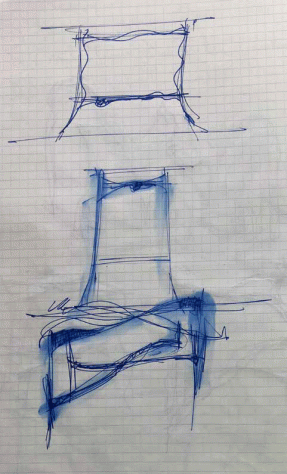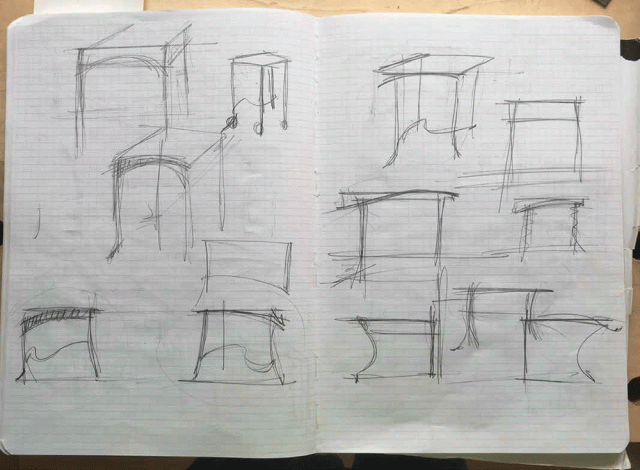
This is an excerpt from “Shaker Inspiration: Five Decades of Fine Craftsmanship” by Christian Becksvoort.
Craftsmanship is a tough concept to get your head around. Even the dictionary gives it short shrift. “Skill in a particular craft.” Pretty lame. This is a bit better: “The quality of design and work shown in something made by hand; artistry.” Much closer. I guess it’s one of those abstract impressions that’s hard to define, but you know when you see it. It has to do with skill, accuracy, artistry, expertise, technique, workmanship and sometimes even design. That’s thanks to a hunt through the thesaurus. What all those words have in common is a connection to the human hand and heart. That, I think, reiterates the notion of practice stated in Chapter 2: Do anything long enough and you become good at it. You develop and become proficient at craftsmanship.
I think that brings up the very important notion of standards. What are your standards when building a desk, cutting dovetails or finishing? Chances are that your standards are not mine. We all strive for a different benchmark. I once worked for a fellow whose idea of a finished piece of furniture was anything sanded to #100 grit. He’d become frustrated and pass it off to someone else to complete the sanding process. Let me tell you what a pain it is to sand a piece that is already assembled. In my shop, I generally sand to #400 or #600 grit, depending on the wood and the surface. Yet other woodworkers will insist on sanding to #1,200, while some insist that #200 is smooth enough and you can’t feel the difference. It gets waxed, anyway. The reason I go to #400 or more is that figured cherry sanded to #200 or less appears as “blotchy,” while sanding to #400, #500 or #600 shines the wood and really pops out the grain, so it looks like tiger’s eye when viewed from different directions. When sanding, I work my way up through the grits from #120, #150, #180, #220, #320 and #400, then polish with #0000 steel wool. I start with each grit on an orbital sander, then hand-sand with that same grit to remove swirls. When completed, there will be no swirls, and the surface will be smooth and polished to reflect light. If it looks good and feels good, it is good. Would sanding through to #1,200 make a difference? I’m not sure that a discerning individual could tell the difference. Is that extra little bit worth the added time it would take? That depends on your definition of perfection, your standards.

Some folks prefer handplaning to sanding. I have no argument with that. I, too, prefer it when possible. Handplaning may be a bit more difficult, but if done right yields a smooth reflective surface. If you experience tear-out, either your plane is dull or your technique needs upgrading.
But in some instances, sanding is preferable – for example, dovetailed drawer sides. Block planes with low angles are perfect for the end grain of pins and tails. If, however, the flat grain is figured or goes downhill, the block plane will tear it to shreds. So you go for a high-angle smoother, right? It will work wonders on the figured flat grain, but tear your end-grain pins and tails to shreds. Ever try to plane between the pins and stop exactly at the half-blind front? I’m not saying it’s impossible, just frustrating and time-consuming. Sometimes the sander is faster and more efficient, no matter which way the grain runs. To me, it’s a job to be done to perfection, not therapy.

I don’t sand every surface to a high polish. The bottoms of cabinets and the undersides of my tables are smooth to the touch, but those get sanded only to #220 grit. That’s not to say I try to cut corners; rather, I try to work efficiently. My prices are pretty dear, and adding 10 or 20 percent more time to an already time-consuming project begs the question, “When do you quit?” To put it more precisely, I try to put my efforts where they will show and have the most impact.
I guess that everyone’s standards are different. That’s why I don’t have employees. I know of one woodworker who in fact does sand to #1,200 grit. Honestly, I can’t see or feel the difference between #600 and #1,200. How much time do you want to spend to achieve perfection? If your piece is 99.9 percent perfect, is it worth another three or four hours to get to 99.99 percent perfection? Who decides? Of course if time is not an issue, then it’s a moot point. I’ll go into this a bit more in Chapter 7.
On the other end of the spectrum are the historical purists, who insist on building the way some craftsmen in the 18th and 19th century worked. One woodworker stated that historical mistakes were fine to be reproduced. “I prefer to go with what was original. The panel may crack a little, but as they say here in Maine, ‘it won’t bother.’ It’s normal to see modest splits in the sides of period case work…” Really? I know for a fact that doesn’t jive with the Shaker work ethic. Some of those cracked antiques were most likely built by those who didn’t know any better. Not only that, but they didn’t have to deal with forced-air heat. Why would you build a piece knowing full well it was going to crack? I like to think that we learn from our mistakes, as well as the mistakes of others, and hence improve. I don’t think that any craftsman working for a living 100 or 200 years ago would consciously build in a fashion that he knew full well would fail. That’s not my idea of old-fashioned craftsmanship – but as I stated, everyone is entitled to set their own standards and opinions.
— Meghan B.